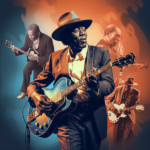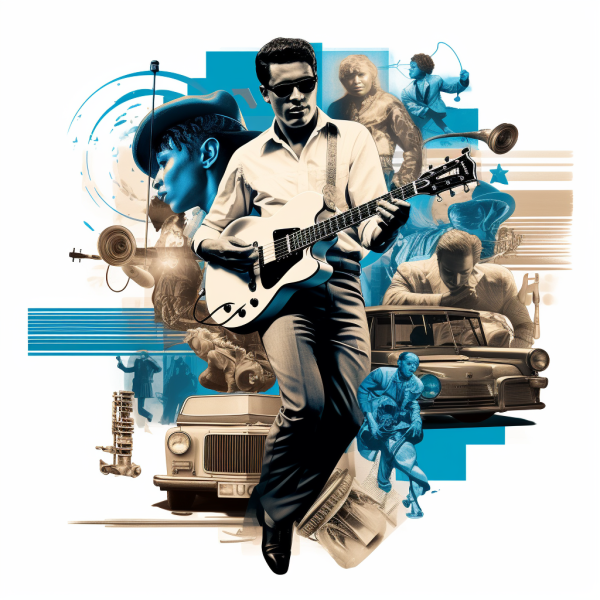The Impact of Blues on Rock ‘n’ Roll: A Deep Dive into the Roots of a Musical Revolution
In the heart of American musical history lies a profound connection between two genres that have shaped the very essence of popular music: blues and rock ‘n’ roll. The blues, with its origins in the African American experience, and rock ‘n’ roll, a quintessentially American creation, are not only musical genres but cultural phenomena that have left an indelible mark on the world. This article delves into the intricate web of influence that binds blues and rock ‘n’ roll, tracing the evolution of this musical revolution that has captivated generations. As we embark on this journey, we’ll explore the iconic crossover artists and songs that bridge the gap between these two genres, uncovering the profound impact of blues on the birth and growth of rock ‘n’ roll.
1. Blues Origins: The Soul of a Nation
To understand the profound influence of blues on rock ‘n’ roll, we must first explore the roots of the blues itself. Emerging from the deep South in the late 19th century, the blues was born from the struggles and sorrows of African Americans. It was a raw, emotional expression of their experiences, often set against the backdrop of oppression, segregation, and hardship. The blues became a powerful form of storytelling, a musical narrative that resonated with listeners from all walks of life.
2. The Birth of Rock ‘n’ Roll: A Fusion of Styles
The birth of rock ‘n’ roll in the mid-20th century marked a seismic shift in the music landscape. It was a genre that defied conventions, blending elements of rhythm and blues, country, gospel, and of course, the blues. Pioneering artists like Chuck Berry, Little Richard, and Fats Domino brought their blues-infused styles to the forefront of this burgeoning genre. “Maybellene” by Chuck Berry and “Tutti Frutti” by Little Richard are prime examples of songs that captured the raw energy and rhythm of the blues while injecting a new, electrifying spirit into the mix.
3. Crossover Icons: From Muddy Waters to Elvis Presley
The crossover between blues and rock ‘n’ roll was not a one-way street. Blues artists like Muddy Waters, Howlin’ Wolf, and B.B. King found themselves at the crossroads of genres, influencing not only the music of their contemporaries but also a new generation of rock ‘n’ roll musicians. The electrified sound of Muddy Waters’ “Hoochie Coochie Man” and the soulful guitar work of B.B. King on “The Thrill Is Gone” were pivotal in shaping the rock ‘n’ roll landscape.
4. The British Invasion: When the Blues Crossed the Atlantic
As rock ‘n’ roll crossed the Atlantic, it found a new home in the hearts of British musicians who embraced the blues with fervor. Bands like The Rolling Stones, The Yardbirds, and Led Zeppelin drew inspiration from American blues masters, adapting their songs and styles to create a unique British rock sound. The Rolling Stones’ rendition of “I Can’t Quit You Baby” and Led Zeppelin’s “Whole Lotta Love” are shining examples of this blues-rock fusion.
5. The Blues Revival: Keeping the Flame Alive
While rock ‘n’ roll continued to evolve, the blues never lost its essence. The 1960s and ’70s saw a blues revival with artists like Stevie Ray Vaughan and Eric Clapton bringing the genre back to the forefront. Clapton’s “Layla” and Vaughan’s blistering guitar solos breathed new life into the blues, ensuring its legacy remained vibrant.
6. Contemporary Echoes: Blues in Modern Rock ‘n’ Roll
The influence of blues on rock ‘n’ roll continues to echo through contemporary music. Artists like The Black Keys, Jack White, and Gary Clark Jr. seamlessly blend bluesy undertones with rock ‘n’ roll energy, pushing the boundaries of both genres. “Lonely Boy” by The Black Keys and “Seven Nation Army” by Jack White’s The White Stripes are modern classics that pay homage to their blues roots.
Conclusion: A Timeless Bond
In the tapestry of American music, the connection between blues and rock ‘n’ roll remains unbreakable. The blues provided the emotional depth and storytelling prowess, while rock ‘n’ roll injected the rebellious spirit and innovation. Together, they birthed a musical revolution that transcended generations, cultures, and boundaries. From the smoky juke joints of the Mississippi Delta to the global stages of rock ‘n’ roll, this partnership has left an indelible mark on the soundtrack of our lives. As we celebrate the iconic crossover artists and songs that bridged these two worlds, we bear witness to the enduring impact of the blues on the ever-evolving journey of rock ‘n’ roll. It’s a connection that will continue to inspire and resonate for generations to come, a testament to the power of music to transcend time and place.









